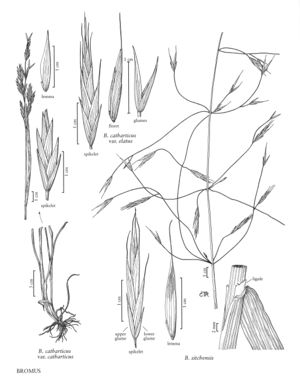Difference between revisions of "Bromus catharticus var. catharticus"
FNA>Volume Importer |
FNA>Volume Importer |
||
| Line 15: | Line 15: | ||
-->{{Treatment/Body | -->{{Treatment/Body | ||
| − | |discussion=<p | + | |discussion=<p>Bromus catharticus var. catharticus is native to South America. It has been widely introduced in the flora region as a forage crop and is now established, particularly in the southern half of the United States. It usually grows on disturbed soils.</p> |
|tables= | |tables= | ||
|references= | |references= | ||
| Line 31: | Line 31: | ||
|basionyms= | |basionyms= | ||
|family=Poaceae | |family=Poaceae | ||
| + | |illustrator=Cindy Roché | ||
|reference=None | |reference=None | ||
|publication title= | |publication title= | ||
|publication year= | |publication year= | ||
|special status= | |special status= | ||
| − | |source xml=https:// | + | |source xml=https://bibilujan@bitbucket.org/aafc-mbb/fna-data-curation.git/src/314eb390f968962f596ae85f506b4b3db8683b1b/coarse_grained_fna_xml/V24/V24_274.xml |
|subfamily=Poaceae subfam. Pooideae | |subfamily=Poaceae subfam. Pooideae | ||
|tribe=Poaceae tribe Bromeae | |tribe=Poaceae tribe Bromeae | ||
Revision as of 16:06, 30 October 2019
Plants annual or biennial; tufted. Culms 30-120 cm, erect or decumbent. Sheaths usually densely, often retrorsely, hairy, hairs sometimes confined to the throat; ligules 1-4 mm, glabrous or pilose, erose; blades 4-26 cm long, 3-10 mm wide, glabrous or hairy on both surfaces. Panicles 9-28 cm, open, erect or nodding; lower branches 1-4 per node, spreading or ascending, with 1-5 spikelets. Spikelets 20-30 mm, with 6-12 florets. Lower glumes 5-7-veined; upper glumes 9-13 mm, (7)9(11)-veined; lemmas 11-20 mm, glabrous or scabrous, sometimes pubescent distally, (9)11-13-veined; awns absent or to 3.5 mm; anthers about 0.5 mm in cleistogamous florets, 2-4 mm in chasmogamous florets. 2n = 42.
Discussion
Bromus catharticus var. catharticus is native to South America. It has been widely introduced in the flora region as a forage crop and is now established, particularly in the southern half of the United States. It usually grows on disturbed soils.
Selected References
None.
